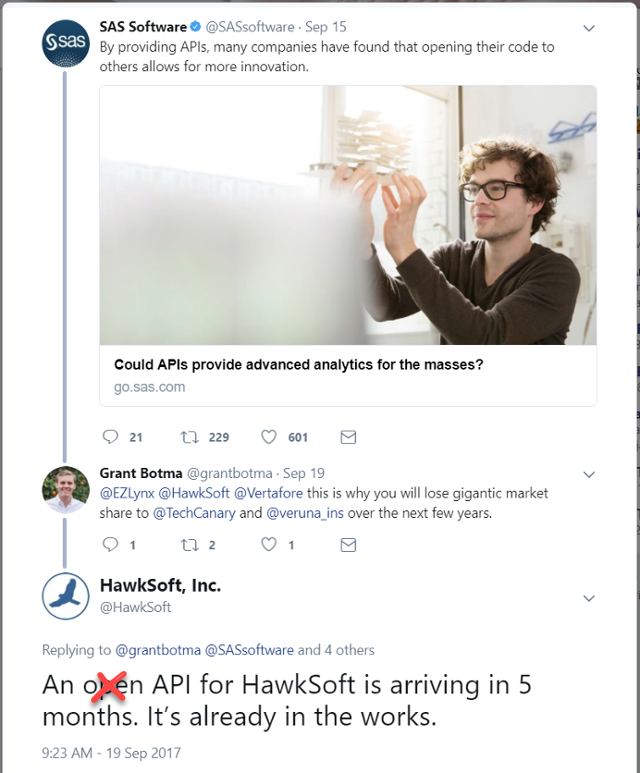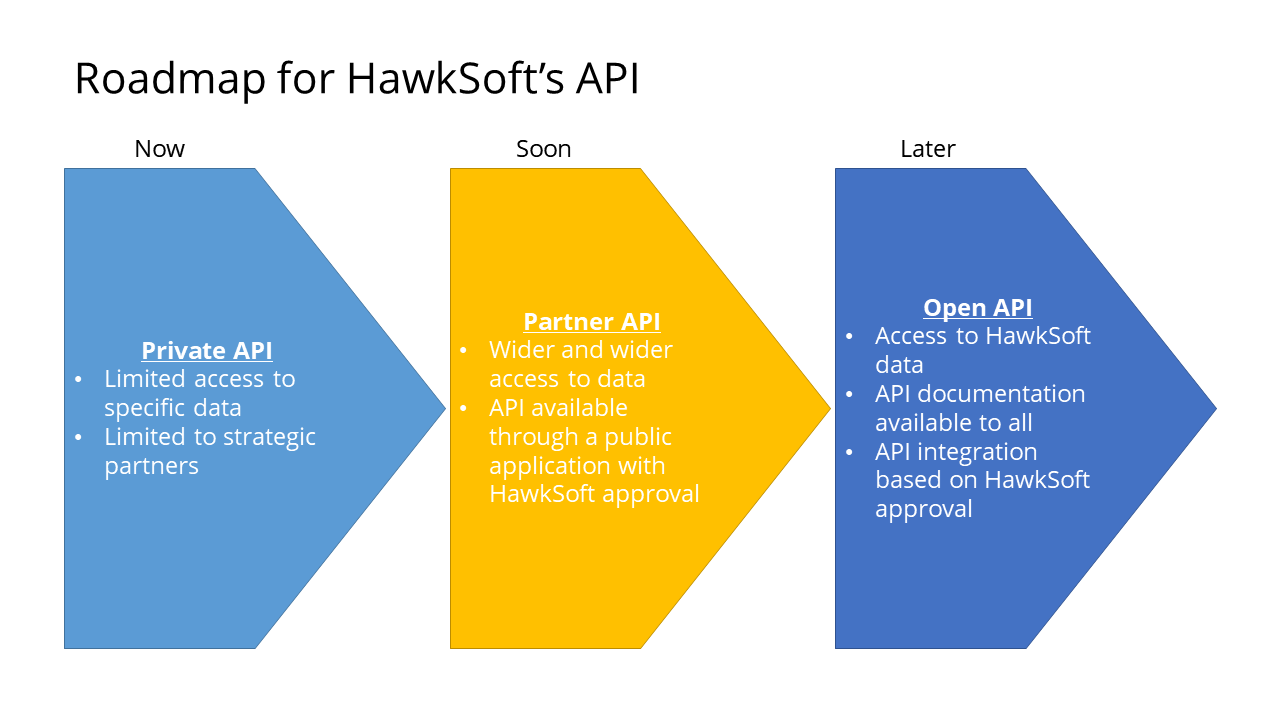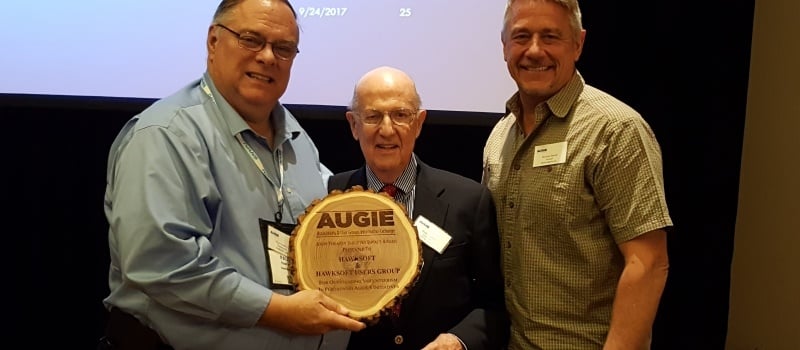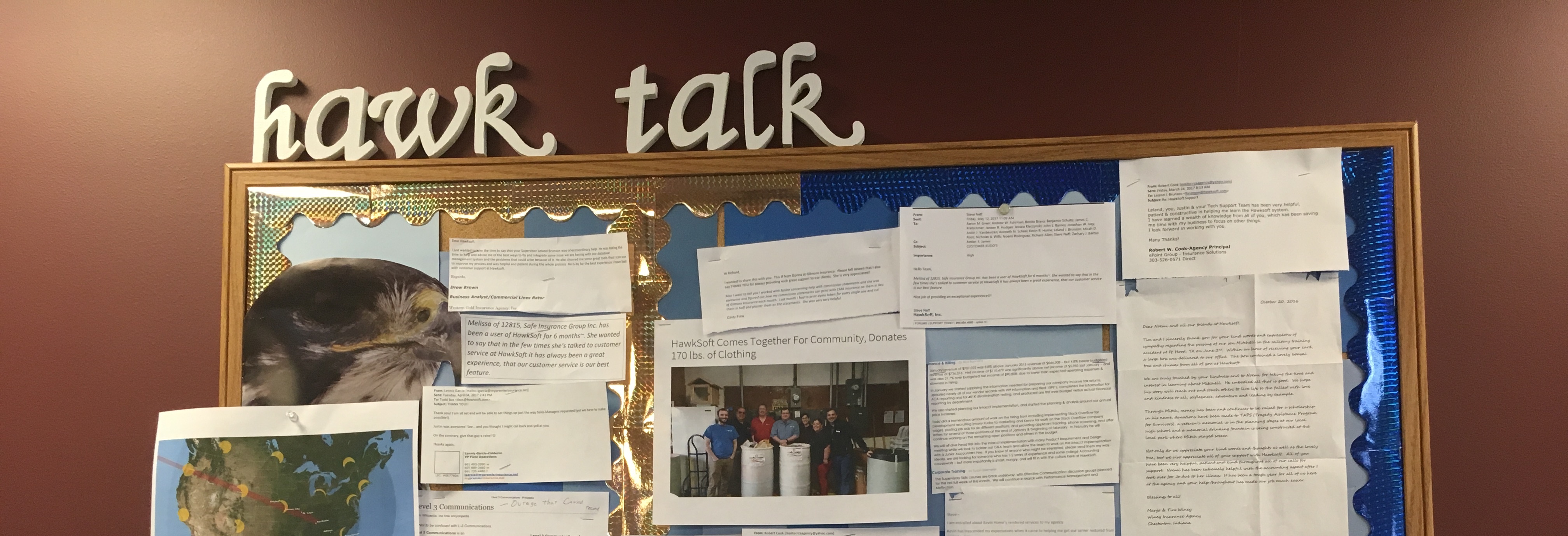UPDATE JANUARY 2022: For the most recent information about the HawkSoft Partner API, read our 2022 Partner API Update
In September, HawkSoft gave in to a truly 21st century impulse: we engaged after being called out on Twitter.
Here’s the tweet:

Our exchange was picked up by Shefi Ben-Hutta of Coverager, the phenomenal insurtech news site with an engaging nightly newsletter.
But… our reply had broken a cardinal rule set by software development teams. Never (ever!) talk dates. While the statement we made is mostly factual (more on "open API" below), the specifics are obfuscated by Twitter’s 140 character limit. This is what I aim to correct today.
This blog will start with the fundamentals: what is an API? What is an Open API? From there we will discuss what APIs mean to our insurance industry, how agencies can leverage them, and outline HawkSoft’s plans with API.
API vs. Open API
What is an API?
APIs are the cornerstone of modern software development. The acronym stands for “Application Programming Interface.” There are several excellent guides to what this means, but I’ll use my favorite by Carey Wodehouse of UpWork to quickly summarize what an API is. An API is “an interface the software uses to access whatever currency it needs: data, server software, or other applications.” Carey’s full breakdown is worth a read and her analogy of an API as an ATM can’t be topped.
I have an example you’re likely familiar with in HawkSoft, although I doubt you are aware it is an API. Have you ever entered a VIN# into our system only to have the vehicle Make, Model, and Year automatically flood the Vehicle Information screen? HawkSoft uses an API from VinLink to pull off that magic trick.
Let’s break down the ABCs of an API:
- “A” is for Application: the application is the software, server, or database you want data from. In our example, the application is VinLink and its database of VIN# with corresponding vehicle details.
- “P” is for Programming: the programming is work done by a software developer (or team) to access the application and exchange data using services. HawkSoft’s Development Team did the programming to make HawkSoft talk to VinLink.
- “I” is for Interface: the interface is a protocol for (standard means of) exchanging data between two systems. This data is exchanged through the use of services defined by the application and called by the programming. VinLink’s API has a VIN Lookup service that HawkSoft calls on through the VIN# field. By entering a VIN# you tell the API to give vehicle information to HawkSoft.
HawkSoft wrote programming code to make HawkSoft CMS and VinLink talk to each other, which is triggered through the VIN# field when entering a vehicle’s information. That’s a HawkSoft feature enabled by an API, and you likely use it every day.
Tech Talk from Sean Hawkins: An interface is something that can be engaged with. It defines the interaction between two systems. A User Interface defines the interaction between the User and some other system such as the input screen on a database or a keypad on a security system. Similarly, a Programming Interface defines the interaction a programmer must interact with in order to access a system.
What is an “Open” API?
Technically speaking, HawkSoft already has an API. We call it the “Partner API.” It is used by key strategic partners of HawkSoft to integrate their marketing tools and comparative raters. The Vendor API is not an Open API. Instead, it would be classified as a Private API. Let’s explore the difference with help from API Academy’s lesson on API Strategy:
- “A private API is an interface that opens parts of an organization’s backend data and application functionality for use by developers…”
- “An open API is an interface that has been designed to be easily accessible by the wider population of web and mobile developers.”
HawkSoft has opened access to specific areas of our software and data. This is textbook private API. What we are building towards, however, is a more open API. We want the data in HawkSoft accessible to web and mobile developers who can build additional functionality to do cool things with our data. I know that could sound scary to an agency using HawkSoft, but rest assured that the permission to access your data will always be the agency’s choice. Agencies - not HawkSoft - will control whether API access is allowed for your agency’s data.
Before we dive into our API plans, I want to detour into our industry at large.
API Buzzwords and Industry Jargon
Most agency management systems don’t have an open API as defined above. What they have is a private API that they like to market as an open API.
Our industry - as a whole - is guilty of a lot of technical debt (old technology or software), which is hidden behind a smoke screen of buzz words like open API and “the cloud.” Sean Hawkins, VP of Development and Co-founder of HawkSoft, wants to fix that.
“When discussing APIs with anyone in our industry, you should require them to be clear about what they mean and what it means for you.”
That’s fair. And since we’re bringing it up, let’s start with HawkSoft. Here we go.
An API is useless for independent insurance agencies unless they find a software developer to code to the API
The existence of an open API doesn’t mean much unless you are or have access to a software developer. Here’s the rub with any API: they are not light switches. The existence of an API doesn’t mean your management system can instantly talk to your favorite app or service. A developer is required to link the two systems through programming (recall, that is the P in API). VinLink and HawkSoft didn’t spontaneously start talking thanks to the existence of VinLink’s API. Our Development team had to program the connection.
An open API does, however, have the potential to mean a lot. Once the HawkSoft API is ready, it will become infinitely easier to form partnerships with the companies that our agencies rely on, in addition to HawkSoft, to run their businesses. The Partner API will open all the doors to anyone we grant the API key to, and the future open API will do the same for anyone with a desire, the resources to program their software or web-services, and approval from HawkSoft to work with HawkSoft CMS.
HawkSoft will integrate with more strategic partners and will be able to do so faster. We also listen closely for what our customers use and want to use with HawkSoft. The partner API will speed up how we respond to customer demand. Important point: the desire must be mutual. If a 3rd party doesn’t want to integrate with HawkSoft, we can’t force them to the table. Sean adds, “In like manner, HawkSoft may choose to not allow access to their API to certain applications in order to ensure a better user or business experience. Think iOS vs Android. iOS requires a vetting process to have Apps placed on their App Store vs Android allows all apps, even ones that do not provide a good experience or are possibly dangerous.” You - as a customer of that company’s services - wield tremendous power to influence them to integrate with HawkSoft or to influence HawkSoft to let them integrate when the time comes.
NOTE:
Our analysis of available APIs in our industry is based on two independent competitive analyses conducted by myself and our Product Owner Chet Amborn. If we got anything wrong, please let me know at marketing@hawksoft.com. This blog post is intended as an honest discussion about APIs and I will happily correct any incorrect information.






